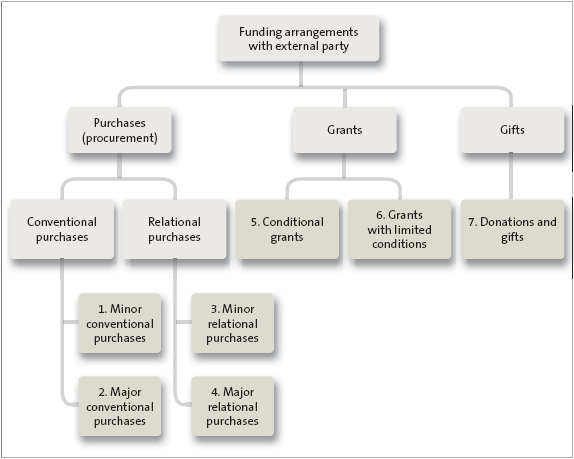The spectrum of funding arrangements
For those entering into funding arrangements, an important first step is to understand the underlying nature and purpose of the arrangement, so that expectations are clear and the arrangements can be structured and managed appropriately.
A commonly used and simple typology asks whether the fundamental purpose of the arrangement is to buy, invest, or give to the external party:
- “Shopping” or “buying” arrangements (procurement) are a form of purchase, and can range from simple and low-value purchase transactions to major construction or other infrastructure developments that may be managed through full and formal procurement processes.
- “Investing” arrangements often take the form of grants, and are designed to build capacity or to support a particular activity or organisation.
- “Giving” arrangements, along with donations and other forms of unconditional grants and payments, are where the public entity provides something without any conditions attached.
Thinking about those three broad groups can help public entities to clarify the basic purpose or nature of what they are trying to achieve with any particular programme of funding arrangements. However, for practical purposes it is useful to go a step further and think about the different types of arrangements within each of those broad groups.
Therefore, as a second stage, we have broken procurement into four subsidiary categories:
- major and minor conventional contracts operating in an ordinary market situation; and
- major and minor contracts with a significant relationship dimension (which we term “relational purchases”).
Similarly, we divide the category of grants into conditional grants and those with only limited conditions, to distinguish between major funding support for substantial projects or development activity (which is likely to attract significant controls) and more easily managed or minor grants (which may have fewer conditions attached).
It would be possible to break down these categories further. For example, we could differentiate between small simple gifts or donations and more substantial grants with no conditions attached, or between major contracts that are once-only purchases and major contracts that involve long-term supply chain arrangements. Equally, it would be possible to collapse the categories into two major groups – grants and contracts. However, for practical purposes, we have found it useful to work with these seven categories.
Figure 1 shows the way in which we divide the general area of funding arrangements with external parties into seven categories.
Figure 1: The seven categories of funding arrangements with external parties

These are not inflexible categories. One type of arrangement can blur into the next, and a funding arrangement with an organisation may have several dimensions to it. We and others have described a continuum or spectrum of arrangements, from formal or simple contracts, to contracts with a relationship focus, through to conditional and unconditional grants and gifts. A highly specified or conditional grant can look very similar to a relational purchase contract. The distinction between a minor purchase and a major one is also subjective. Even though the lines between the categories are not solid, it is useful at a practical level to identify the different types of funding arrangements as a starting point for guidance on appropriate administration and management.
Figure 2 shows the different types of funding arrangements as a spectrum, as well as the guidance documents from the Office of the Auditor-General that are relevant to each.
Figure 2: The spectrum of funding arrangements and relevant OAG publications
| Funding arrangements | OAG good practice guides | ||||
|---|---|---|---|---|---|
| Overarching guide | Procurement | Public private partnerships | NGO funding arrangements | Sensitive expenditure | |
| Minor conventional purchase |  |
||||
| Major conventional purchase | |||||
| Minor relational purchase | |||||
| Major relational purchase | |||||
| Conditional grant | |||||
| Grant with limited conditions | |||||
| Gift or donation | |||||
